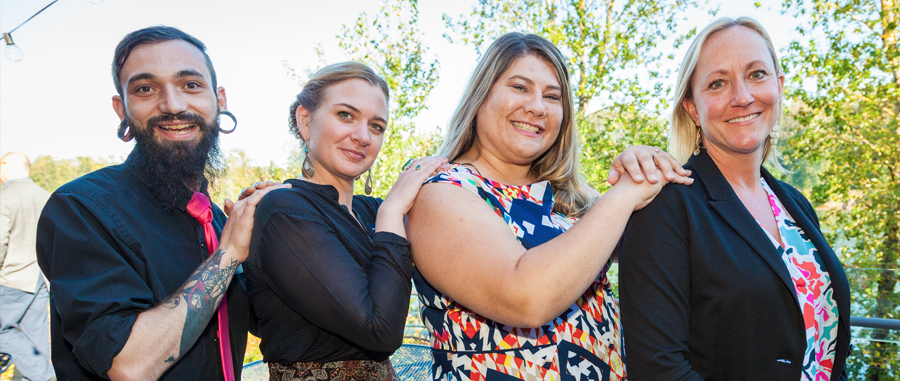The 2024 ACHS Commencement activities included an immersive and educational experience for graduates and their friends and family: The second annual Botanical Walk. The walk took place the day before the commencement ceremony on June 13th at the Hoyt Arboretum in Portland. Professor Amanda Lattin, Dean of Aromatherapy, and Dr. Judith Thompson, Dean of Herbal Medicine, guided the participants through the lush gardens, revealing the secrets of botanicals and aromatherapy. The Botanical Walk offered a chance to connect with nature and the ACHS community in a tranquil and inspiring setting, serving as a perfect prelude to the commencement celebration.
A Growing Tradition
This is the second year ACHS has offered the Botanical Walk experience in conjunction with commencement. It’s a great opportunity to acquire in-person, profound herbal wisdom from holistic health experts. Interacting with living plants can help herbalists and aromatherapists better identify and understand the complex nature of plant life and create a more enriching relationship with herbs and oils. The annual walk is also an excellent way for grads, students, and faculty to meet, mingle, and discuss their favorite herbal topics! The annual event is expected to grow and continue at future commencement ceremonies.
“Every moment we spend in nature is an opportunity for healing. The more familiar we are with the elements of nature, the more healing we can experience. Breathing, listening, observing, touching, and tasting (when safe) gives us a deeper connection and understanding to the direct healing available to us”.
- Judith Thompson, Dean of Herbal Medicine
Beauty and Diversity of Hoyt Arboretum
Established in 1928 to conserve endangered species and educate the community, the Hoyt Arboretum is the perfect backdrop for the Botanical Walk. Although it’s in close proximity to downtown Portland, it spans 190 ridge-top acres and offers 12 miles of hiking trails. With 2,300 species of trees and shrubs from six continents, Hoyt Arboretum offers a range of botanical wonders to explore.
A Journey Through Local Plantlife
On the walk, the group reviewed a number of local plants and trees. They started with a species of the Arctostaphylos genus that was a beautiful, small, winding tree with smooth, red bark and discussed the healing benefits of the more commonly used Arctostapylos uva ursi to support urinary tract health. Also identified was the Oregon grape Mahonia aquifolioum, which grows in various places in the arboretum. Dr. Thompson and Professor Lattin discussed the efforts of the United Plants Savers to protect at-risk species. Since Oregon grape root is now on the at-risk list, they have provided plant analogs with similar effects to give the at-risk species a chance to grow.
The group also came across various trees- Grand fir Abies grandis, Coastal redwood Sequoia sempervirens, and Incense cedar Calocedrus decurrens. They observed the fresh growth on the tree tips and smelled the different aromas coming from the numerous trees. While discussing the various healing components of each tree, participants enjoyed a sample of balsam fir Abies balsamea essential oil to compare the smell in nature versus an organic concentration from a bottle. It was a special in-real-life moment to see the differences between what nature provides and how we can work with it after making a preparation from the raw source.
Exploring the Healing Power of Plants
Throughout the arboretum, Professor Lattin and Dr. Thompson pointed out a sprinkling of everpresent dandelions Taraxacum officinale and discussed how the different parts of dandelion heal certain body parts. They also noted how prevalent false dandelion Hypochaeris radicata was and how to differentiate it from true dandelion (it shoots up a long stem in the middle with numerous flowers and has shorter, thicker, and hairier leaves). There were some large-leaf maple Acer macrophyllum leaves lying around, and there was a scattering of wide-leaf plantain Plantago major. Students who came in from the East Coast noticed how different both plants were on the West Coast.
The group also spotted some yellow dock Rumex crispus. It still had its fresh yellow color and was not yet recognizable by the Doctrine of Signatures. Next, they encountered an elder Sambucus nigra and discussed how it was widely used a few years ago, considering its broad usage as a plant with the leaf, stem, flower, and berry being edible. An important disclaimer was reiterated: Do not eat the uncooked berries and seeds due to their cyanide content, and always strain the seeds when preparing elderberry syrups.
The walk concluded with a Black walnut Juglans nigra tree. It majestically hovered over the group and provided much-welcomed shade as they discussed its uses as an anthelmintic. Many thanks to Professor Lattin and Dr. Thompson for leading this fun, educational, and inspiring adventure!
Take the Next Step
-
Learn more about ACHS's Herbal Medicine Programs
-
Learn more about ACHS’s Aromatherapy Programs
-
Learn more about ACHS's Doctor of Science in Integrative Health with Herbal Medicine Specialization
-
This article is for informational purposes only. Please contact ACHS Admissions at admissions@achs.edu or 800-487-8839 for additional information and to apply for admission. Graduation from any ACHS program does not confer a license to practice medicine. ACHS graduates do not claim to treat, diagnose, cure, or prescribe. Please note that professional success is achieved by a number of factors beyond education and experience, including soft skills, work ethic, integrity, and other skills that may not be developed through education and training alone. Not all graduates will achieve the career outcomes provided as examples in this article and other ACHS marketing materials.






